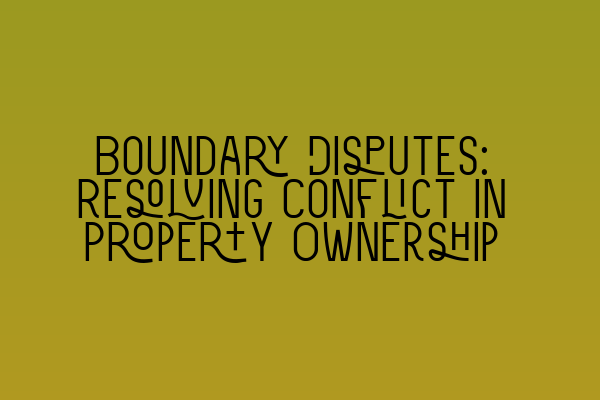Boundary Disputes: Resolving Conflict in Property Ownership
Property ownership is an important aspect of our lives. It provides us with a sense of stability and security. However, when boundary disputes arise, they can quickly turn a peaceful property ownership into a battleground of conflicting interests. Resolving such conflicts can be a daunting task, but with the right approach and legal expertise, these disputes can be successfully resolved.
Understanding Boundary Disputes
Boundary disputes typically occur between neighbors who have different interpretations of where their properties’ legal boundaries lie. This can happen due to a lack of clarity in property documents, changes in boundary lines over time, or simple misunderstandings.
When faced with a boundary dispute, seeking legal advice is crucial. A competent property law solicitor can offer you the guidance necessary to understand your rights and obligations, assess the strength of your claim, and explore potential solutions.
Steps to Resolve a Boundary Dispute
Resolving a boundary dispute requires a multifaceted approach that combines legal expertise, negotiation skills, and a willingness to explore alternative dispute resolution methods. Here’s a step-by-step breakdown:
- Consult a property law solicitor: It’s essential to consult a solicitor who specializes in property law to assess the validity of your claim and guide you through the legal process.
- Gather evidence: Collect any relevant documents, such as property deeds, survey reports, and photographs, that can support your case.
- Negotiate with your neighbor: In many cases, boundaries can be agreed upon through amicable negotiation to avoid court proceedings. Engaging in open and respectful communication with your neighbor can lead to a mutually acceptable resolution.
- Mediation: If direct negotiations fail, consider mediation. A trained mediator can facilitate discussions between both parties, helping them find a compromise that satisfies their interests.
- Consider arbitration: Arbitration is a process where an independent third party, known as an arbitrator, makes a legally binding decision on the dispute. This option can save time and money compared to court proceedings.
- Instruct a surveyor: If the dispute involves complex physical boundaries, it may be necessary to hire a surveyor to accurately determine the property lines.
- File a lawsuit: If all else fails, you may need to take the dispute to court. In this case, your property law solicitor will guide you through the litigation process and represent your best interests.
Each case is unique, and the appropriate course of action will depend on the specifics of your situation. Your property law solicitor will guide you in choosing the best approach to resolve your boundary dispute.
Avoiding Future Boundary Disputes
Preventing boundary disputes is always preferable to resolving them. Here are a few proactive measures you can take:
- Get a detailed survey done before buying a property to ensure clear boundary lines.
- Review and understand your property’s deeds and any relevant agreements.
- Maintain open lines of communication with your neighbors to address any potential issues or concerns.
- Document any changes made to the boundary lines over time.
- Consider creating a legally-binding agreement with your neighbor regarding the boundaries.
By taking these precautionary steps, you can significantly reduce the likelihood of future boundary disputes.
At SQE Property Law & Land Law, our team of experienced property law solicitors can provide you with the expert advice and representation you need to resolve your boundary dispute effectively. Contact us today to schedule a consultation and protect your property rights.
